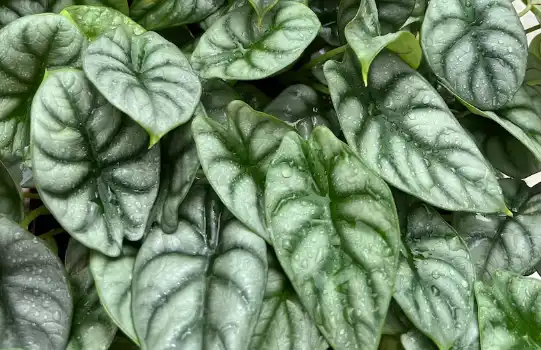Alocasia plumbea nigra care, propagation-All you need to know
Do you want to keep a unique plant in your houseplant collection? Then, you should certainly think of alocasia plumbea ‘nigra’. Along with its beautiful dark green and wavy foliage, you can maintain it easily.
How to care for plumbea nigra? Well, it needs 60-85°F temperature, partial shade condition, watering once a week, slightly acidic soil and 60-70% humidity along with an easy propagation procedure. But make sure it has not faced overwatering, underwatering, disease attack or over-fertilization. Otherwise, brown or curly leaves problems can arise.
So, scroll below and get detailed information about this plant.
Alocasia plumbea ‘nigra’ Overview
| Scientific name | Alocasia plumbea nigra |
| Family | Araceae |
| Origin | Indonesia |
| Other names | Black metallic taro |
| Plant height | 3-5 ft tall |
| Plant type | Perennial plant |
| Leaf | Dark green leaves |
| Stem | Purple colored stems |
| Sunlight | Partial to full shade |
| Watering | Once a week |
| Humidity | 60-85°F |
| Temperature | 60-70% |
Where to buy alocasia plumbea ‘nigra’?
Getting alocasia plumbea ‘nigra’ may be bothersome for you if you are in a tropical region. You can search for it in the nursery. Otherwise, online shops like Etsy are always ready to reach you with this beautiful plant.
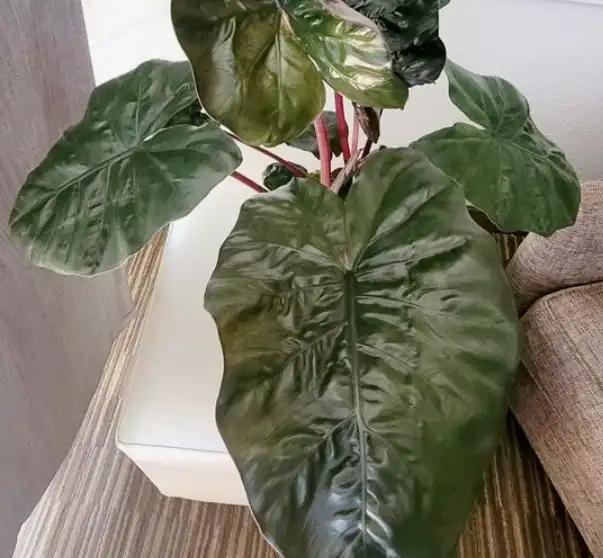
Alocasia plumbea ‘nigra’ plant care guide
Now, I will suggest to you the caring guides of alocasia plumbea ‘nigra’. The segments of care that I am going to discuss here are-
- Light requirement
- Watering guide
- Best soil medium
- Temperature and humidity measurement
- Best fertilizer
Light requirement
Alocasia plumbea ‘nigra’ loves to stay in partially shady conditions. Full sunlight is problematic for their body activities. If you put them in scorching light for hours, the leaves get burnt and the plant becomes stressed. So keep them in partial shade for their better development. That’s why they are easy to maintain as indoor plants.
Watering guide
The next one is watering techniques. You should water your plant once or twice a week. But make sure that the soil has enough moisture but no water is clogged in the soil. You should notice if the drainage is proper or not.
Best soil medium
I recommend slightly acidic soil having a pH of 5.0-7.5 as the plant rooting medium which is highly enriched with nutrients. You can mix perlite, coco coir or sphagnum moss with the soil. It will work as a supportive nutrient. The soil should have moisture-retaining quality and proper aeration stability.
Temperature and humidity measurement
In the case of temperature measurement, I always suggest keeping the range between 60°F to 85°F. This temperature is favorable for the growing condition and reproductive period of the plant. Along with this, you have to maintain appropriate humidity that is 60-70%.
Best fertilizer
The final one is the fertilizer requirement. Don’t over-fertilize your plant as it will make the leaf burn and kill the plant. As plumbea ‘nigra’ is a hardy plant, it needs fertilizing once a year in the early summer or late spring. Additionally, you can use liquid fertilizers for them during their growing period. Dilute the fertilizer with water and pour it while watering.
Alocasia plumbea ‘nigra’ plant propagation
Now, comes the propagation procedure. For a well-developed new plant, an undisturbed propagation period is an important issue.
Mother plant selection: Firstly, you have to select a healthy mother plant that is disease-free and well-established.
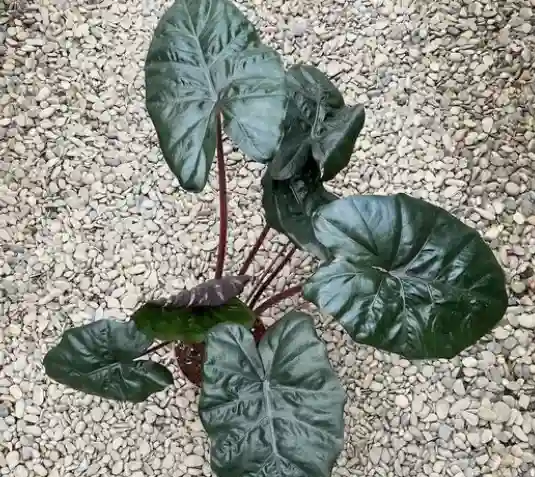
Dividing stem: Then, cut the stem into short parts with rootlets. Use disinfected scissors or knives for this purpose.
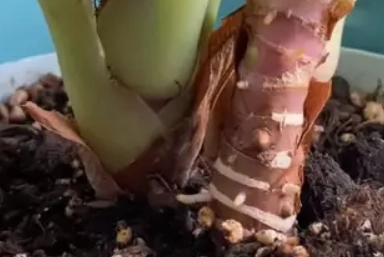
Planting: Place the cutting in the pre-prepared soil which is made ready by mixing soil, coco peat and perlite.
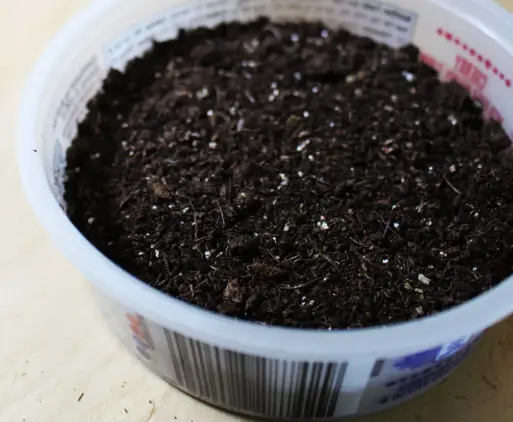
Aftercare: Water your plant regularly but moderately so that water cannot clog. Provide proper microclimate for its advantages.
How to repot alocasia plumbea ‘nigra’ plant?
Repotting plumbea nigra is an easy procedure but it requires skills. Firstly, you have to uproot the plant without damaging the roots. Then, take a new pot and prepare it with the soil mixture you made during propagation. Finally, plant it in the prepared pot.
Why are my alocasia plumbea ‘nigra’ leaves turning brown?
Alocasia plumbea ‘nigra’ can turn brown due to overwatering or over-fertilization. When you water them more than it’s necessary, the root system faces stress and a root rot problem is initiated which is expressed through brown leaves. Again, too much fertilizer concludes in leaf burn making the leaf brown.
Why are my alocasia plumbea ‘nigra’ curling?
Alocasia plumbea ‘nigra’ leaves may become curly and crispy because of underwatering and excessive temperature. Too much temperature makes the leaves dry. If you don’t water your plant properly at that time, the cells of the leaves get dry and finally it becomes crispy and curly.
Alocasia plumbea ‘nigra’ vs colocasia royal hawaiian punch plant
If you want to notice the similarities between alocasia plumbea ‘nigra’ and colocasia hawaiian punch, you will see wavy leaves and reddish stems. It may confuse you until you are properly conscious about their leaf color. The hawaiian punch plant has moderately dark green leaves whereas the plumbea plant possesses extremely dark green foliage.
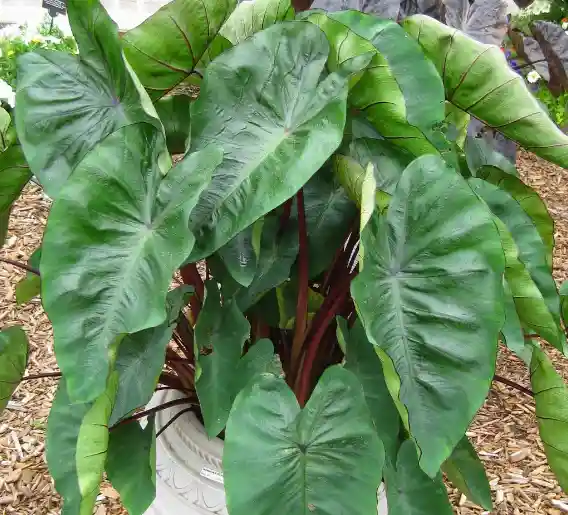
Alocasia plumbea ‘nigra’ vs Colocasia diamond head plant
Next, you can be confused between the dark green and purplish color of alocasia plumbea ‘nigra’ and colocasia diamond head. Both of the leaves are wavy and their surface is smooth, but the leaf color of the diamond head is near to purplish.

Alocasia plumbea ‘nigra’ vs alocasia macrorrhiza plant
Here, you can get differences between two alocasia varieties which are macrorrhizae and plumbea ‘nigra’. Again, the leaves are wavy but color makes the difference. Macrorrhiza has green foliage but the plumbea possess a darker green surface than macrorrhiza.

Is alocasia plumbea ‘nigra’ an indoor plant or an outdoor one?
You can maintain alocasia plumbea ‘nigra’ best as an indoor plant as the maintenance of temperature, humidity and other factors is easy inside the house. You cannot regulate the outside weather easily.
Final thoughts
Finally, I have to end this article here as I have already included the basic information about this plant. The main advantage of this plant is you can maintain it in any situation without excessive struggle.
Caring guides, propagation methods and problems related to this plant are described earlier as I experienced before. So check the points and apply them to your plant to cope with any problem or confusion. Hopefully, you will get better results if you can follow them properly.

![Alocasia Odora care, propagation, leaves problem [All you need to know]](https://diaryforgardening.com/wp-content/uploads/2022/09/Alocasia-Odora-care.webp)



![These are 14 Trees with Fern-like Leaves [Pictures & Details]](https://diaryforgardening.com/wp-content/uploads/2022/02/Trees-with-fern-like-Leaves.jpg)
